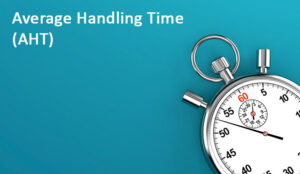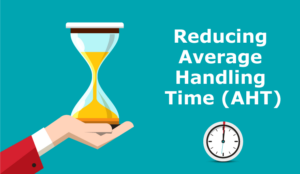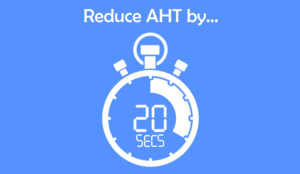Who hasn’t wished for a smooth customer care experience? Yet it often feels like a distant dream.
We’ve all been there – talking to customer service can test anyone’s patience. Your customers deserve better. They want their issues sorted quickly or might check out the competition.
The good news? There’s a way to avoid that. AHT, or Average Handle Time, is a metric that measures the time your support takes to address customer inquiries or problems. Nailing this is key to keeping problems away.
Call Centre Helper Magazine says a good Average Handle Time is about 6 minutes per call or interaction.
Yet it’s not as uniform as other common contact centre metrics and can vary across businesses. Remember, a higher AHT doesn’t always have a negative impact. Sometimes, it signifies a more thorough customer care approach.
In this article, Ruthie Carey at Five9 looks at what is average handle time (AHT), how to calculate it, and how to improve it in a contact centre.
The Vital Role of Contact Centre Metrics
Contact centre metrics act as the guiding compass in customer service and support. They provide insights into various aspects of contact centre performance and customer interactions.
Understanding these metrics can make a huge difference in your customer service quality.
Contact centre metrics quantitatively measure key performance indicators (KPIs) directly tied to your contact centre’s success.
These metrics include average handle time (AHT), customer experience, customer satisfaction, hold time, and the number of calls handled.
Each of these metrics offers valuable insights into how well your contact centre is performing and how efficiently it operates.
In essence, contact centre metrics serve as your complete toolkit as a contact centre manager or supervisor.
They equip you with actionable insights that support data-driven decision-making. These insights aid in refining processes, enhancing customer interactions, and optimizing operational efficiency.
By closely monitoring these metrics, you can swiftly adapt to changing customer needs and fine-tune your strategies accordingly.
Contact centre metrics are not just numbers on a dashboard; they are the pulse of your contact centre operations.
Embracing these metrics gives you the power to proactively address challenges. Ultimately, this approach elevates the entirety of your customer service experience.
What Is Average Handle Time (AHT)?
Average Handle Time (AHT) is vital to your contact centre management. It offers you insights into operational efficiency and customer service excellence.
AHT includes the overall time an agent engages with a customer, from start to finish. It provides an overview of your contact centre efficiency and the efficacy of customer interactions.
AHT includes crucial components shaping interaction duration:
- Talk Time: The period of active conversation addressing customer queries.
- Hold Time: Time customers spend on hold while awaiting assistance.
- After-Call Work (ACW): Post-interaction tasks, such as updating records, scheduling follow-ups, and handling transfers or escalations.
The impact of AHT resonates across your contact centre operations. It facilitates optimal resource allocation by determining interactions per agent within a timeframe. Reducing wait times enhances the customer experience and increases agent efficiency.
Effective AHT management controls operational costs through efficient resource utilization. It underscores the need for well-trained agents proficient in communication and problem-solving.
Thus, ensuring a balance between speed and quality, AHT stands pivotal for streamlined operations and enhanced customer interactions in your contact centre.
A Salesforce study confirms positive customer experience matters greatly. About 88% of customers highlight the significance of a company’s provided experience, equivalent to its products or services. And 96% assert that excellent customer service nurtures trust.
In light of these insights, AHT becomes more than just a metric. It transforms into a tool that measures efficiency and symbolizes the commitment to delivering exceptional service.
This alignment resonates with your customer’s desire for a memorable and trust-building engagement.
How to Calculate Average Handle Time
Consistently tracking AHT enables you to assess and enhance your customer interactions seamlessly. Here’s a step-by-step guide to show you how to calculate average handle time:
Step 1: Identify Key Components
AHT comprises essential components: talk time, hold time, and after-call work (ACW) time.
Step 2: Gather Data
Acquire data for each component over a representative period of customer interactions. To ensure accuracy, this period should encompass diverse call types, agent expertise, and customer issues.
Step 3: Calculate Total Handle Time
Sum the talk, hold, and ACW time for all interactions during the chosen period.
The formula for total handle time is:
Total Handle Time = Total Talk Time + Total Hold Time + Total ACW Time
Step 4: Determine the Number of Interactions
Count the total interactions within your selected period.
Step 5: Calculate AHT
Utilize the data from steps 3 and 4 to compute AHT using the formula:
AHT = Total Handle Time / Number of Interactions
Step 6: Analyze Results
After calculating AHT, analyze the data to gain insights into agent performance, contact centre efficiency, and potential areas for enhancement.
Comparing AHT across agents, teams, or time frames can yield valuable insights into performance trends.
Step 7: Continuous Monitoring and Improvement
Regularly monitor AHT and adjust based on your analysis. This may involve refining call scripts, optimizing processes, or offering additional agent training for streamlined interactions.
Avoid These Common Mistakes While Calculating AHT
When calculating AHT, account for all call-associated times, such as hold time and after-call work.
Additionally, accurately capture all phone calls handled, including abandoned or unrecorded calls, to attain precise AHT results.
This meticulous approach guarantees an accurate representation of your contact centre’s performance.
Strategies to Improve Average Handle Time in a Contact Centre
Efficiency is the heartbeat of a successful contact centre, and improving Average Handle Time (AHT) is a key objective in enhancing operational effectiveness.
Wondering how to improve average handle time in a contact centre? Here are four best practices that can significantly impact AHT while maintaining service quality:
Optimize Call Scripts and Knowledge Base
Crafting well-structured call scripts and maintaining a robust knowledge base can drastically reduce AHT.
Agents armed with concise and accurate scripts can navigate customer interactions more smoothly.
Providing comprehensive information at their fingertips minimizes the need to place customers on hold to search for answers.
Furthermore, the knowledge base should undergo regular updates, ensuring agents have access to the most current information.
This empowers them to promptly resolve inquiries, eliminating unnecessary delays and enhancing the overall customer experience.
Provide Comprehensive Agent Training
Allocating resources to comprehensive agent training pays dividends in AHT reduction. Equip agents with in-depth product knowledge, effective communication skills, and problem-solving abilities.
Proficient agents can swiftly tackle customer issues. This reduces prolonged interactions that elevate AHT. To ensure a sustained impact, ongoing training sessions should prioritize the development of both hard skills and soft skills.
This approach empowers agents to confidently navigate diverse scenarios. It ensures they possess the finesse to provide excellent customer service while efficiently managing call durations.
Utilize Technology and Automation
Modern contact centres rely heavily on technology. One way to enhance efficiency is using contact centre software incorporating automation. This approach can simplify processes and expedite interactions.
For example, an intelligent virtual agent can handle repeat, routine inquiries. Additionally, pre-populated customer information and real-time reporting contribute to time savings.
Moreover, providing agents with screen-populated relevant information empowers them. This empowerment enables agents to promptly address customer issues. Thus preventing unnecessary search and call transfers.
Implement Efficient Call-Routing Systems
Effective call routing is important to ensure customers are swiftly directed to the appropriate agents. Implementing intelligent call routing which considers customer profiles, issue complexity, and agent expertise eliminates the need for multiple transfers.
This approach reduces AHT and enhances the customer experience by connecting customers with agents capable of providing immediate assistance.
A well-executed call routing strategy achieves higher first contact resolution, decreased average handling time, and optimized agent utilization.
Partnering for AHT excellence
Embracing excellence in Average Handle Time (AHT) becomes effortless when partnering with our Intelligent Virtual Agent, an industry-leading provider of cloud contact centre solutions.
The IVA redefines the customer engagement landscape by empowering agents to connect with customers seamlessly across various communication channels.
This platform grants managers unparalleled visibility into contact centre performance and instills agility into business operations.
The fusion of human capability and cutting-edge technology lies at the heart of the IVA approach. This union that drives customer experience (CX) success while nurturing the joy of CX.
The transformative potential of IVA emerges by incorporating AI, which empowers your workforce and advances the contact centre domain through a potent CX platform.
The Intelligent Customer Experience Platform aligns with customer preferences, harnesses practical AI, automation, and cloud capabilities to elevate business agility, and consistently surpasses customer expectations.
The financial benefits of cloud-based contact centre software are substantial. A commissioned Total Economic Impact (TEI) study by Forrester Consulting unveiled a potential 213% ROI from implementing Five9 IVA cloud contact centre software.
This blog post has been re-published by kind permission of Five9 – View the Original Article
For more information about Five9 - visit the Five9 Website
Call Centre Helper is not responsible for the content of these guest blog posts. The opinions expressed in this article are those of the author, and do not necessarily reflect those of Call Centre Helper.
Author: Five9
Published On: 6th Oct 2023 - Last modified: 9th Dec 2024
Read more about - Guest Blogs, Five9






 Five9 empowers organizations to create hyper-personalized and effortless AI-driven customer experiences that deliver better business outcomes. Powered by Five9 Genius AI and our people, the Five9 Intelligent CX Platform is trusted by 3,000+ customers and 1,400+ partners globally. The New CX starts here and it's at the heart of every winning experience.
Five9 empowers organizations to create hyper-personalized and effortless AI-driven customer experiences that deliver better business outcomes. Powered by Five9 Genius AI and our people, the Five9 Intelligent CX Platform is trusted by 3,000+ customers and 1,400+ partners globally. The New CX starts here and it's at the heart of every winning experience. 









